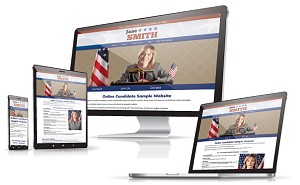At first glance, these items seem obvious, but you would be surprised at how often simple yet important information is left out of campaign websites.
Here is a short list of critical text that should always be included when building out your political campaign website. Leave this information out at your own peril!
1. State/Municipality/Office Sought
It’s amazing how many local political websites say “Candidate X for Mayor”, but don’t actually mention the state that the municipality is located in. If you’re running for office in Orange County, is that Orange County New York or Orange County California? Be specific. Help your visitors (and the search engines).
Add details to your “About” page that provide deeper context about your district and the office you seek. This not only gives voters critical information but also signals more about your election campaign to search engines.
2. The Primary/General Election Date
Don’t assume that everyone knows the day they need to go out and vote for you. Add the year, as well. A lot of old websites out there are asking for votes, even though the election day has come and gone. It’s another good reason to keep your website up-to-date, even after the campaign.
3. Election Information
Include local election information, such as voting locations and how they can register. Link out to your local or state election information, as well as related pages—like your candidate profile, FAQs, and press releases—that can provide voters with a larger picture of your campaign’s operations and milestones.
Get Free Campaigning Tips: Subscribe for free guides and updates from Online Candidate.
4. Specific Local Issues
Be specific. The more local the campaign, the more specific the issues become. Don’t just say ‘our traffic problems’, say ‘TinyTown’s traffic problems’ or even specific highways or roads. Consider linking to detailed policy pages or blog posts that elaborate on these issues. This approach enriches the voter’s understanding and creates a network of internal content that strengthens your overall message.
5. Full Contact Information
Provide full contact information for your campaign. This will be helpful to both voters and the media. After all, if they can’t easily contact you when you’re running for office, why would they think you would be more responsive when you’re actually elected?
This information is what search engines look for when displaying search results for campaign-related queries.
Tip: Don’t forget to include the candidate’s name! Too many times we see websites written in the first person, where the candidate is referred to as ‘I’ or ‘my’. Without an actual name in the copy, how can you expect search engines to know who “you” are?
If you want to write in the first person, try adding a quote box and a call to action written in the third person. Mentioning your full ballot name, position sought, and location is critical for optimizing your website.
Integrating Internal Linking Within Your Broader Campaign Strategy
Beyond the basics of listing key information, internal linking plays a huge role in unifying your campaign message. By strategically linking related content—such as policy details, event updates, and media appearances—you can create a cohesive narrative that improves your site’s SEO. An interconnected structure also reinforces your key messages and helps voters easily access additional resources.
Incorporate this information into your site, and site visitors (and voters) will have no doubt about who you are, what you are running for, and what you stand for!
Related:
- Writing Content For Your Campaign Website – Examples
- Write an Optimized Political Press Release
- Creating a Political Campaign Swipe File
Get your campaign website created faster and easier with Online Candidate. Our system is designed for political candidates and organizations. Use our built-in tools and resources to improve your online campaign. Which services are best for you?
179 Years of Presidential Slogans [Infographic] »






